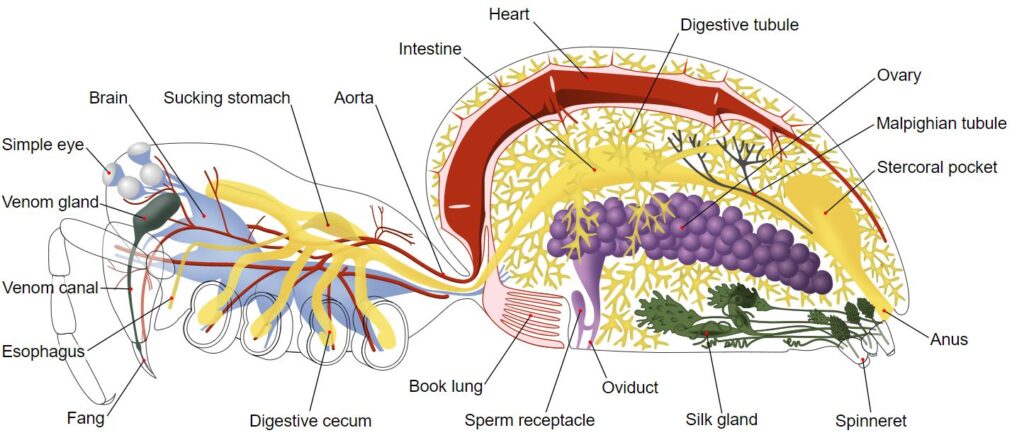
Do spiders have hearts? That’s an interesting question. Would it make you feel guilty for all the times you’ve squished one if we said yes? Or do you just think they’re so gross anyway, it doesn’t really matter. To be fair, if you’re not a fan of spiders, why would you? However, first and foremost, lets answer that quickly, then we can delve more deeply into it.
Yes, spiders have hearts. It is located in the abdomen a short distance within the middle line of the dorsal body-wall, and above the intestine. Unlike in insects, the heart is not divided into chambers, but consists of a simple tube.
If you only wanted a yes or no answer, there you have it. However, if you’re interested and would like to know more, let’s break down the anatomy of a spider to fully understand the job of the heart and take a look at other spider organs.

Heart, continued….
Spiders, like most arthropods, have an open circulatory system, i.e., they do not have true blood, or veins which transport it.
| Open Circulatory System | Closed Circulatory System |
|---|---|
| Organs bathed in blood | Organs are not in immediate contact with blood |
| It takes a long time for blood to cycle through | Blood cycles through quickly |
| Blood flows slowly | Blood flows quickly |
| Does not require a lot of energy to operate | Requires a lot of energy to operate |
Also, unlike our blood, arachnid blood appears blue-ish or clear, as they do not have hemoglobin (which is responsible for our blood’s colour).
Rather, their bodies are filled with haemolymph, which is pumped through arteries by the heart into spaces called sinuses surrounding their internal organs.
To straighten and bend all eight legs so they can move, haemolymph is pumped into the legs.
It is also responsible for transporting oxygen, nutrients, and hormones throughout the arachnid body. In some species, it is also used to increase the blood pressure during molting, or skin shedding.
The haemolymph contains hemocyanin, a respiratory protein similar in function to hemoglobin. The aorta, which supplies haemolymph to the cephalothorax, extends from the anterior end of the heart.
Smaller arteries extend from sides and posterior end of the heart. A thin-walled sac, known as the pericardium, surrounds the heart.
How do Spiders Breathe?
Spiders have developed several different respiratory anatomies, based either on book lungs or on tracheae.
Book lungs are not comparable to the lungs of modern land-dwelling vertebrates. Their name describes their structure and purpose.
Stacks of alternating air pockets and tissue filled with hemolymph give them an appearance similar to a “folded” book.
Tracheae are thin tubes that branch around the body. These tracheae may possibly have evolved directly from the book lungs because the tracheae in some spiders have a small number of greatly elongated chambers.
Many arachnids, such as mites and harvestmen (Opiliones), have no traces of book lungs and breathe through tracheae or through their body-surfaces only.
Digestion
Digestion is carried out internally and externally.
Spiders do not have powerful fangs but secrete digestive fluids into their prey from a series of ducts perforating them.
They release these digestive fluids to dissolve the prey’s internal tissues. Then the spider feeds by sucking the partially digested fluids out.
Other spiders with more powerfully built fangs masticate the entire body of their prey and leave behind only a relatively small amount of indigestible materials.
Spiders are only capable of consuming liquid foods and many spiders will store prey temporarily.
You may want to read our article on removing the fangs from a tarantula here.
We hope that’s answered the question more fully. Even if you’re not a fan, you have to admit that spiders really are remarkable creatures, that’s why we love them!
Until next time, stay spidery!
